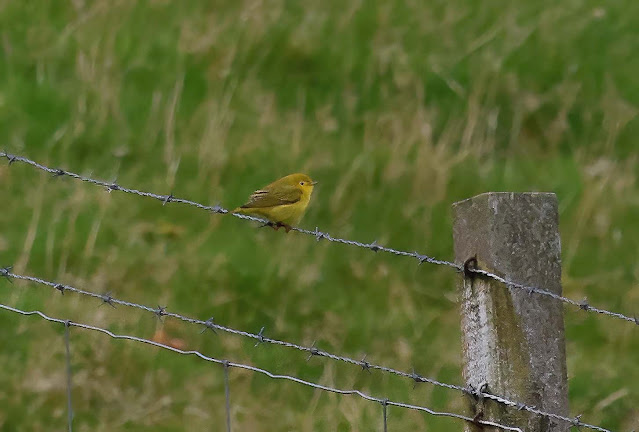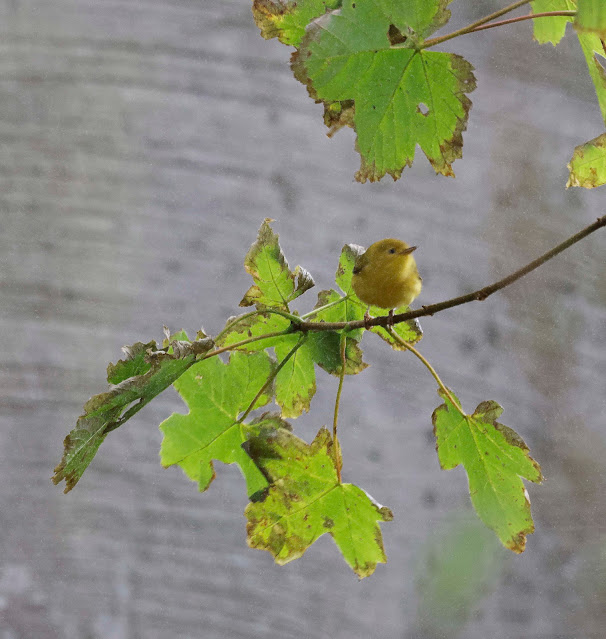It was getting towards the end of our two weeks on Shetland and today, Thursday the 12th of October the weather had finally relented from the preceding two day onslaught of gale force winds and stinging rain to something less apochryphal.We decided we would go to Unst as there was nothing exceptional to tempt us on Mainland. Unst offered the opportunity to see an Arctic Redpoll and possibly a Pied Wheatear and the island has long been a favourite of mine.
We were some miles north of Lerwick near Kirgord, gently cruising along on our way to Toft to catch a ferry to Yell and then onwards to Unst when Mark made one of his regular checks of BirdGuides.
There's a Yellow Warbler just been discovered at Hoswick. Turn round!
I did an immediate u turn on the empty road and we made full speed for Hoswick which lies between Lerwick and Sumburgh and was just half an hour's drive from our present position.
My heart was racing, that heady combination of excitement and anxiety that takes control of my emotions when a mega is found. There have only been six accepted records of a Yellow Warbler in Britain.This was truly a mega of megas.
If we saw the warbler it would be a second British tick for me on this Shetland trip, to go along with the Veery we had seen on our first day on Shetland.What an autumn it has been for American warblers.This would be my fourth new American warbler species this year following the three seen in Wales in September. Utterly extraordinary.
Turning off the main road we descended into Hoswick. As expected all possible parking places had been commandeered by other birder's cars so we drove back up the hill and parked where we would not upset anybody.
We walked back downhill to where the road crossed Hoswick Burn and the village climbs up the side of the hill opposite.
It was fairly obvious that the warbler was not on view as various birders were standing around looking hopefully at trees and bushes.We met Rob by the burn who told us the warbler had been discovered at the back of the now closed Orca Inn further up in the village but had been lost to view.It had been photographed and it definitely was a Yellow Warbler, probably carried across the Atlantic by the westerly gales of the last two days.
We stood about not quite sure where to go or what to do. Rob's phone beeped an alert.
Here we go boys, it's been relocated at the back of the Orca Inn!
The craziness had begun.
We raced up the hill, round a bend and up a side road that brought us to the defunct Orca Inn and its car park now crammed not with cars but a very large number of birders.With just time to greet Ryan and Vicky who I only ever meet on Shetland in autumn, I commenced joining everyone else in scanning the sycamore trees that encircle and overhang the car park. The warbler had just been seen in a sycamore by the inn but had now flown around the back of the inn. We had missed it by a minute. Would it come back?
The answer was no as it was re-found but only briefly in a fuschia hedge behind the inn. As one we deserted the car park and surged round the inn to view the hedge. We stood and willed it to show itself but there was not a sign of it. Slowly the adrenalin subsided and it was back to looking hopefully at nearby trees and hedges. Birders fanned out scanning every available bit of suitable habitat.Half an hour of frustration and no little anxiety elapsed before it was reported a long way further up a road that continued along the hillside.
In an instant chaos reigned as everyone made off in the direction of this latest sighting,some moving faster than others, a tide of humanity, lugging scopes, tripods, cameras and lenses, running down a rough lane,spilling out onto and then up the road along the hillside.
An excited shout.
There it is!
A chorus of replies.
Where?
Directions were given.
Everyone ran to the spot but the warbler had moved on upwards. Would it ever stop?
Another shout.
It's here in this willow!
But by the time we got there it was on the move again.
The warbler continued to move fast up the road. Always one flight ahead.
Birders in their anxiety lost all sense of reason and ran onto private driveways and even into gardens in pursuit of the warbler until commanded by Hugh H.
Get out of there!
I began to question whether I really wanted to be part of this.It was just like the infamous Lanceolated Warbler twitch of last year at Wester Quarff when a mass hysteria seemed to possess everyone.
Finally, a good way up the road,where there were no further trees, I got to see the Yellow Warbler in a willow right by the road. It was in the middle of the tree and made its way up to the top granting the briefest of views before it flew over the road into some dead willowherb on the side of the hill.
We stood in the road. A mass of birders. I counted in excess of eighty of us. Confusion and excitement. gripped us all in equal measure
Shouted replies It's in the dead willowherb
And then I saw it again.
A dash of bright yellow amongst the reddish brown ranks of the dead willowherb. It flicked up onto the top of a wall and I admired its bright yellow colouring for another few seconds before it dived down into cover.
It moved further down the hillside to a line of willows with a wire fence running parallel to them.
For some minutes it was nowhere to be seen and then it emerged to perch on the fence and for a minute remained there, unmoving. I pressed the camera shutter, more in hope than expectation. It was a long way off. It would be a record shot only but that would do.
The tiny bird flew back into the willows. Two minutes elapsed and it was back out again, perched on the fence once more but between two House Sparrows.
 |
| c Mark |
Then it was off again, gradually moving downhill until it decided to settle in a garden surrounded by conifers and deciduous trees. Sheltered and relatively secure it stopped here.
The garden was soon surrounded by birders and we all saw it well enough as it made occasional appearances in the foliage. Goldcrests moving through the trees fooled us every so often before the warbler's yellowness reminded us how very different it was. Forever on the move, flicking lightening fast on an erratic course through the trees it was virtually impossible to photograph.
The rain returned with a vengeance and the warbler was lost to view for some hours.We were by now very wet, standing morosely around the garden in the wet grass and not enjoying the experience.We decided to leave and come back tomorrow, assuming it would be here. I felt reasonably optimistic that the weather would preclude any overnight departure.
When we got back to Scalloway we heard it had finally been seen again and in the same garden in the late afternoon. Somehow it had been there all the time but hardly anyone was looking for it by then.Whoever saw it must have been drenched and very persevering.
The next day it was still wet and miserable and there was no report of the Yellow Warbler until mid morning when it was located back in the original finding place at the back of the Orca Inn.
We drove there immediately, rain or no rain and as often happens in Shetland the forecast was wrong and the rain, predicted to fall all day, abated although the wind remained but this was of little consequence in the sheltered car park.
When we arrived there were about a dozen birders all looking at the Yellow Warbler as it flicked around in the trees.Every so often it showed itself well, a bright yellow mite amongst the wet and dying foliage pursuing a high speed course amongst the bushes and leaves of the overhanging sycamores.
I took an anxious look at the back of my camera which showed I had got a few images.Hardly the best but good enough to enable me to savour the event and bring back happy memories in the coming winter months.
Who would have thought it.
I had seen a Yellow Warbler.
Third time lucky.
So another thrilling and rewarding two weeks on Shetland came to a close.By any standards it was even better than our trip last year which I thought impossible. The highlights for me were two extended sightings of Orcas, the last within an hour of our Northlink Ferry check in and having to drag ourselves away in order not to miss the boarding deadline. I also relished the extensive and fabulous views of the White's Thrush on Bressay whilst not forgetting the confiding Veery on our first day and the amazing Yellow Warbler arriving two days before we left Shetland. Both British ticks for me.
Shetland is beautiful and awe inspiring in its own unique way, not with the classic Scottish landscape of towering mountains and glens but the barren undulating moorlands, impressive cliffs and the constant presence of the sea are equally inspiring and impressive.Here you can really feel you are on the edge of the world, with space to breath and rejuvenate the spirit.
We saw the following birds and mammals during our stay
Red throated Diver, Northern Fulmar, Northern Gannet, Great Cormorant, European Shag, Cattle Egret, Grey Heron, Mute Swan, Whooper Swan, Tundra Bean Goose, Pink footed Goose, Greylag Goose, Barnacle Goose, Eurasian Wigeon, Eurasian Teal, Mallard, Northern Pintail, Common Pochard, Tufted Duck, Greater Scaup, Common Eider, Long tailed Duck, Surf Scoter, Common Goldeneye, Red breasted Merganser, Merlin, Red Grouse, Common Pheasant, Eurasian Oystercatcher, Ringed Plover, European Golden Plover, Northern Lapwing, Knot, Sanderling, Curlew Sandpiper, Purple Sandpiper, Dunlin, Ruff, Common Snipe, Bar tailed Godwit, Eurasian Curlew, Common Redshank, Turnstone, Great Skua, Black headed Gull, Common Gull, Herring Gull, Great Black backed Gull, Kittiwake, Guillemot, Razorbill, Black Guillemot, Rock Dove, Woodpigeon, Collared Dove, Great Spotted Woodpecker, Sky Lark, Barn Swallow, Olive backed Pipit, Meadow Pipit, Rock Pipit, Citrine Wagtail, Grey Wagtail, White/Pied Wagtail, Wren, European Robin, Bluethroat, Common Redstart, Siberian Stonechat, Amur Stonechat, Northern Wheatear, White's Thrush, Veery (12th record for Britain), Blackbird, Fieldfare, Redwing, River Warbler, Blyth's Reed Warbler, Eastern Subalpine Warbler, Barred Warbler, Common Whitethroat, Blackcap, Greenish Warbler, Yellow browed Warbler, Common Chiffchaff, Willow Warbler, Goldcrest, Red breasted Flycatcher, Pied Flycatcher, Magpie (heard only), Rook, Hooded Crow, Common Raven, Common Starling, House Sparrow, Brambling, Eurasian Siskin, Redpoll sp, Yellow Warbler (8th record for Britain), White crowned Sparrow (12th record for Britain), Snow Bunting, Reed Bunting.


.jpg)
.jpg)
.jpg)


.jpg)



No comments:
Post a Comment